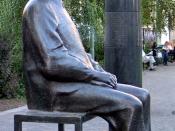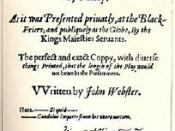Nishtha Tewari
25.09.2012
The Duchess of Malfi: Themes of Blood, Lust, Violence and Intrigue
Set within the Jacobean age, The Duchess of Malfi, is a revenge play that portrays the violence inherent in any society that functions on a blood nobility structure. The play focuses on both the physical and mental aspect of this violence. The structures existing within society and hierarchies important to the functioning of the dukedom lead to the assertion of individual authority over one another. From the very outset of the play, Ferdinand and the Cardinal are seen as 'perverse' creatures susceptible to flattering and pandering by those around them. They flourish in an environment that provides them easy access to imposition of their personal will over others. In the Jacobean era, nobility was a rigid structure and the attempts to break out of their defined roles led to the victimisation of those in the lower rungs of society.
This state of society is brought out through Bosola's comparison of the court to a hospital;
⦠where this man's head lies at that man's foot, and so lower and lower.[0: Webster John, The Duchess of Malfi, Worldview Publications, 1.1.71 ]
The stratification of society, portrayed thus, brings out the the power dynamics inherent in a class based society. The outlaw marriage between the Duchess and Antonio is an example of the break from this social order. While Ferdinand's real motive is a source of constant debate through the play, it can be seen that he wishes the Duchess to act as both a guardian of the nobility and in compliance with the patriarchy. Her marriage then is threatening to Ferdinand's elevation of himself, and by extension, the aristocracy. It suggests that these supposedly determined class categories could be traversed through self-determination and...


